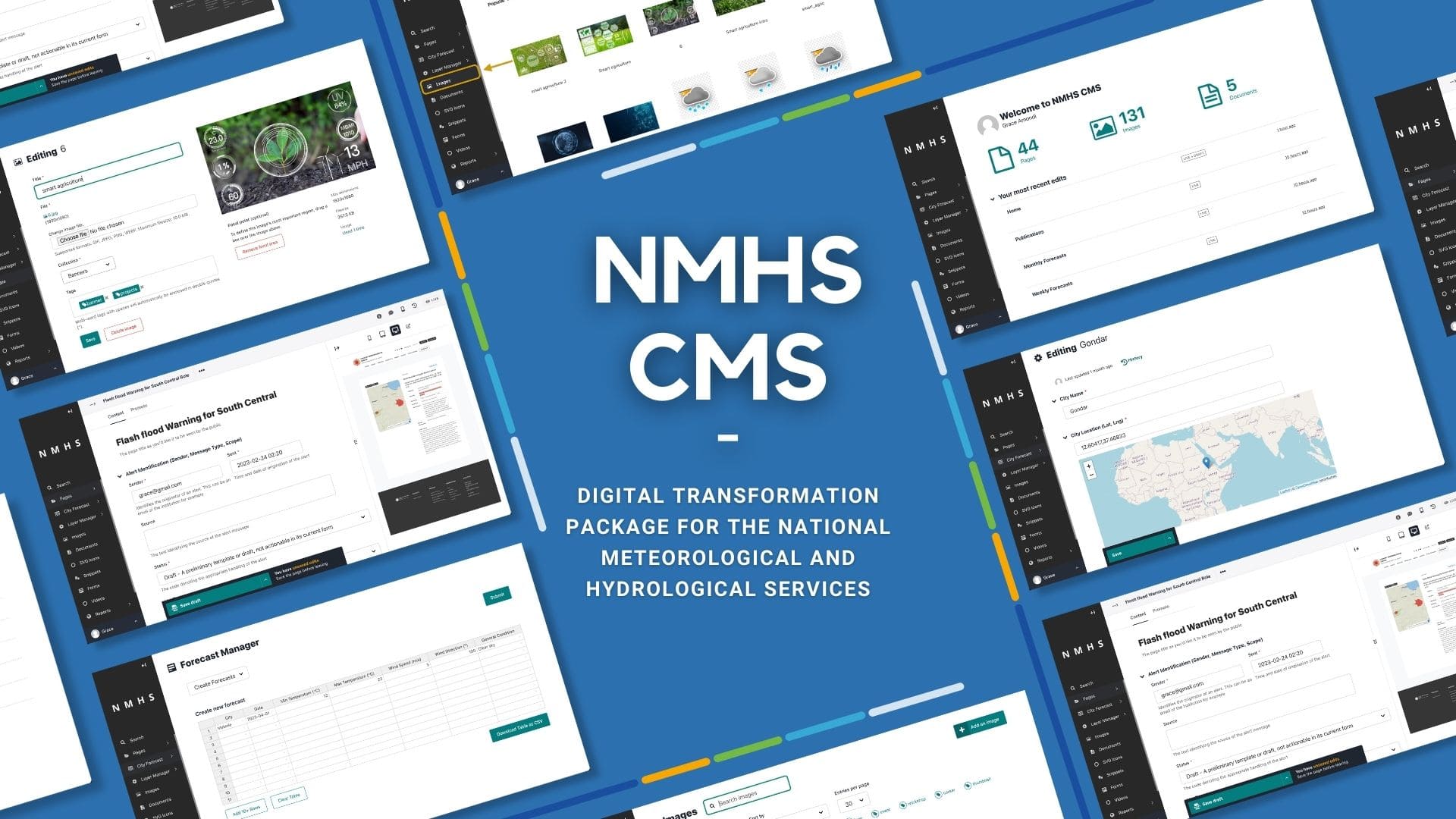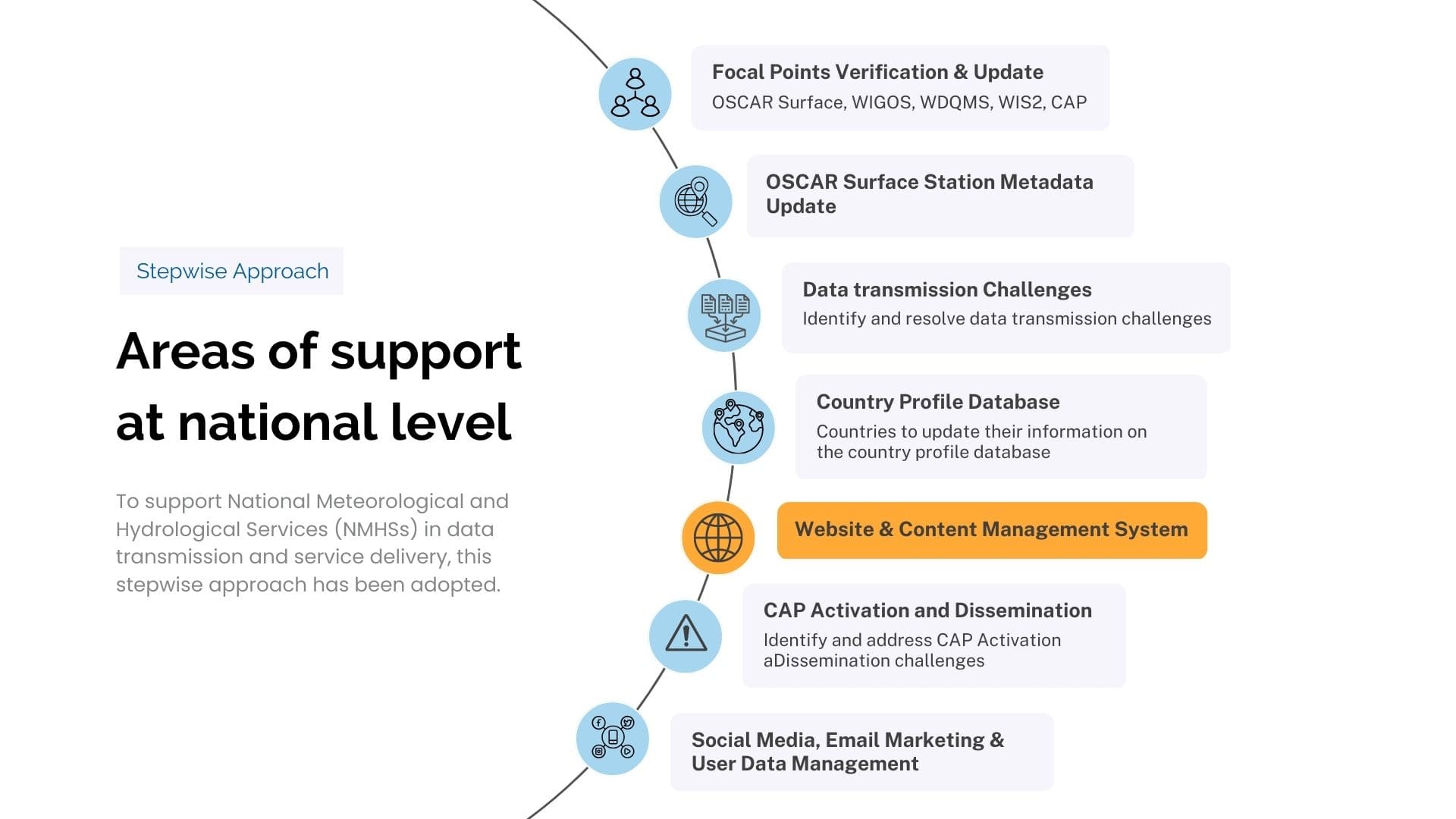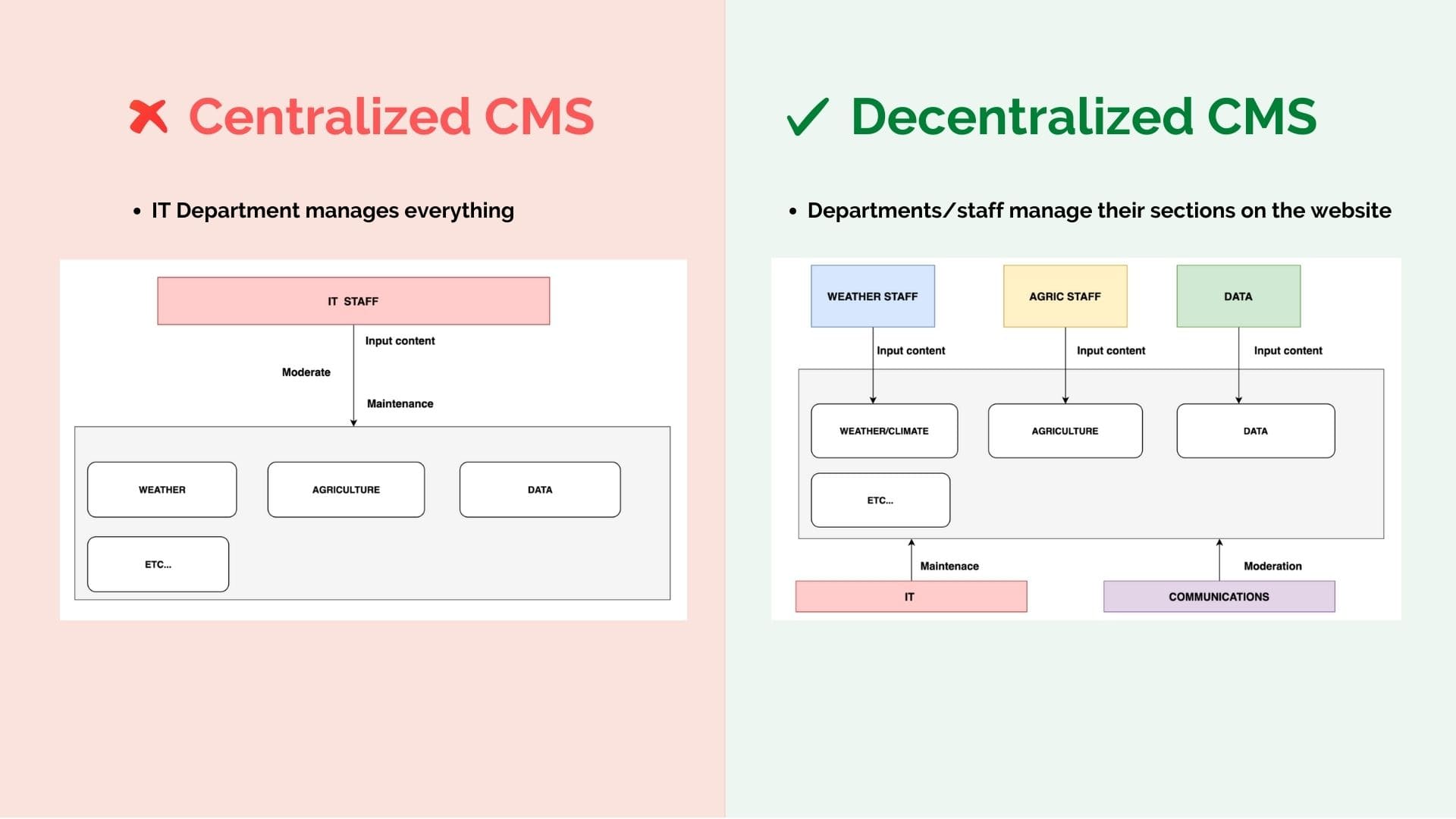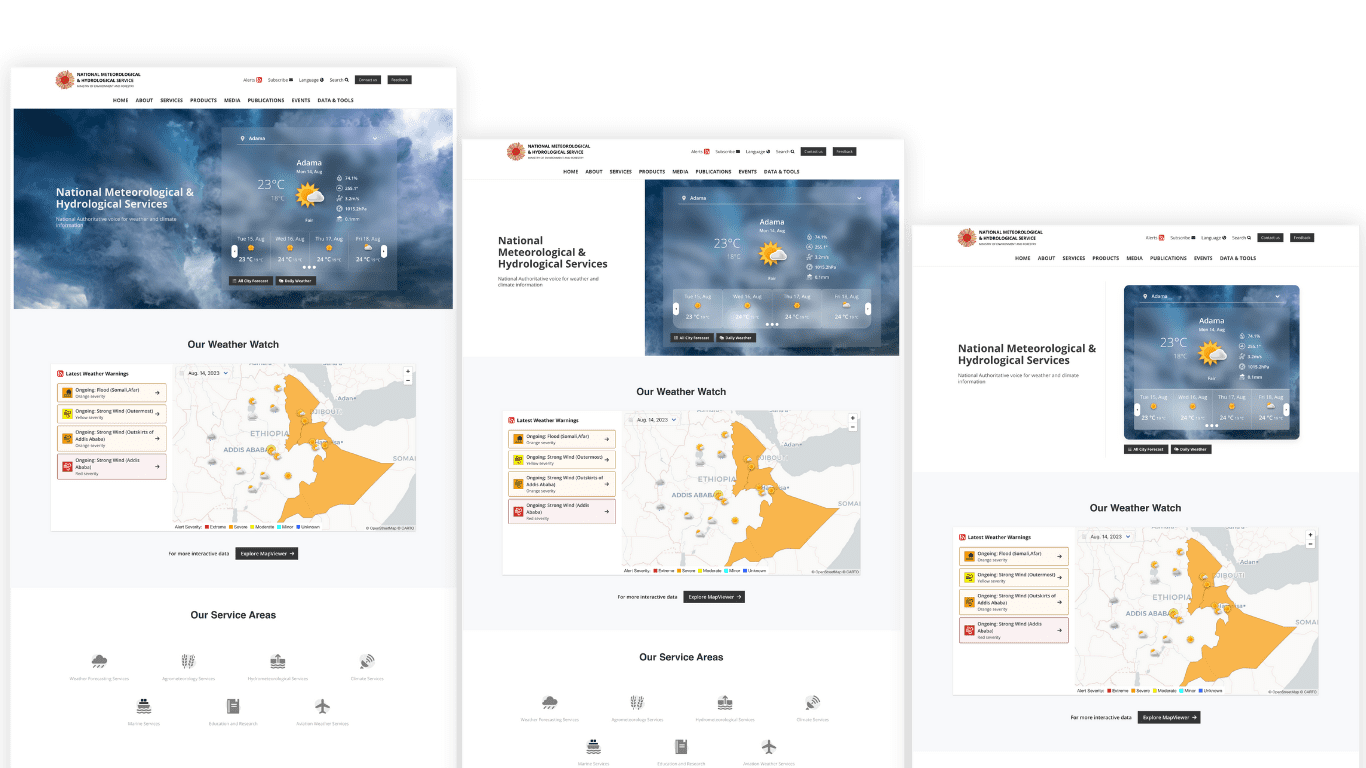
Introduction¶
Amidst escalating and urgent impacts of climate change, Africa exhibits major challenges in coping with its consequences, particularly in terms of controlling extreme weather events, and delivering accurate and timely information to the public.
In response to these challenges, the World Meteorological Organization’s (WMO) Regional Office for Africa launched a Content Management System (CMS) which is a website template, specifically designed to aid the digital transformation of National Meteorological and Hydrological Services (NMHSs) in Africa
This innovative template, built on free and open-source standards, features a modern design, seamless marketing integrations, a user-friendly weather warnings publisher (in CAP Format) and advanced weather and climate data visualization tools.
The technical development of the system has been supported by experts seconded by NORCAP a part of the Norwegian Refugee Council, with guidance of the WMO Regional Office for Africa.
The technical support provided to NMHSs at the WMO Regional Office for Africa include:
Focal Points verification and updates for different WMO Programmes including OSCAR Surface, WIGOS, WDQMS and CAP
OSCAR Surface verification and updates Station Metadata Update
Data transmission challenges identification, troubleshooting and resolution
WMO Country Profile Database updates
Website and Content Management System (CMS) development and support
CAP Activation and Dissemination
Social Media Management and communication, Email Marketing and User Data Management

This document provides an overview of the Content Management System (CMS) and its features, the delivery and support.
This new CMS template offers:
Customisable and modern design
Seamless marketing integrations
User-friendly CAP Warnings Composer
Interactive georeferenced data visualisation for NMHSs weather and climate products, as well as data from external sources.
It adopts best practices in data visualization and hydro meteorological department and climate communications. All components of the website are built on free and open-source standards allowing for collaboration and contribution.
The CAP Warnings Composer is expected to increase the adoption of the Common Alerting Protocol in Africa, key to increasing the reach of alerts, and their connectivity to broadcast, web and mobile networks. Africa remains one of the world’s most vulnerable regions to climate change and increasing extremes. Increasing the protection of the population through improved climate and early warning communications is crucial.
Considerations during the design & development phase¶
During the design and development phase, fundamental factors were taken into consideration to ensure the delivery of a Content Management System that would improve the efficiency of management.

It factored in:
Well defined content structure and pages management,
User-friendly interface with a modern look and feel
Great user experience and ease in locating content
A decentralized CMS architecture was adopted to allow management of departmental sections by different user roles and allow for content moderation and publishing workflows
Currently, most of the NMHSs website’s management is not decentralized. This means that the website is managed by one staff, usually from the IT department. This is not very efficient as every department has its own content, but the content management systems are not user-friendly to allow for easy management of content by different departments. The new CMS template allows for the management of different sections of the website by different staff, thus removing the load from the IT department and allowing for more efficient management of the website.
. 
Delivery and support¶
For a smooth and efficient delivery of the CMS and customization of the website template to the NMHS, a step by step process is adopted. The quality and interactivity of the website is first assessed followed by approaching and presenting the CMS and integrating feedback. Thereafter, willing/potential members for support are identified together with a focal point for coordination. The CMS is then installed and training on the configuration of CMS and customization of the website conducted. Additionally, learning materials, documentations and guides are provided alongside follow-up support in troubleshooting

Core Components and Integrations¶

User friendly website Content Management System
Modern look and design, mobile friendly.
Adopts best practices and designs benchmarked for weather and climate information dissemination for NMHSs in Africa.
Easy to use and customise without technical skills.
Decentralised content management. Different staff can be assigned and manage different sections of the website.
Defined content publishing workflows. Editors and moderators can be defined for every section of the website.
Embedding Multimedia Content - Youtube etc.
Cap Alerts Publishing
Modern Cap Warnings Composer with simple user friendly and mobile friendly CAP alert creation and management.
Moderated Publishing Workflow from CAP composer to approver, including commenting and email notification support.
Conforms to CAP Version 1.2 Standards.
Search Engine Optimisation support to increase visibility and attract targeted traffic to an alert.
Support for Approval Workflow from composer to approver, including commenting and email notification support.
Interoperable XML API of Alert List and Detail for integration with CAP Aggregators
Live CAP creation and editing preview.
Draw / Upload Polygon Functionality for Alert Area/Areas.
Alert to Alert/Alerts Reference Linkage.
Events registrations and Integration with Online Meeting Platforms (Zoom)
Create event registration forms hosted on the website.
Automatically send invitation emails to users as they register to events from the website.
Keep record of all your registrants for internal analysis.
Allow users registering to events to also subscribe to your products.
Interactive Georeferenced data visualisation
Upload and visualise own gridded data (forecasts, advisories, climate data products) on a map.
Upload and visualise vector data (Point, areas) on a map.
Visualise own CAP alerts.
Visualise thematic/sectorial data products interactively.
Integrate external data sources ( from Regional Centers, Global Producing Centers, Satellite, Google Earth Engine etc).
Provide a platform to support impact based forecasts, analysis and advisories.
Email Marketing integration and user analytics
Sign Up forms for users to subscribe to NMHSs products (using Mautic or Mailchimp).
Analyse your email marketing users data.
Survey creation and results analysis
Create custom surveys hosted on own website.
Analyse results on interactive dashboards.
User analytics
User base breakdown (eg. by sectors, gender, geographic area, etc, from user database - email marketing software).
User satisfaction (from surveys) data and trends .
Website traffic analytics (eg. google analytics) .
System traffic analytics (eg. hazards watch) .
Social media analytics
Twitter
Facebook
Instagram
Youtube
 CMS Documentation
CMS Documentation